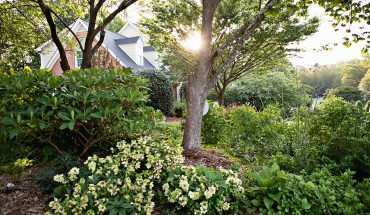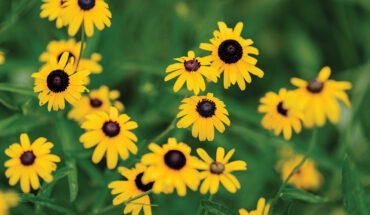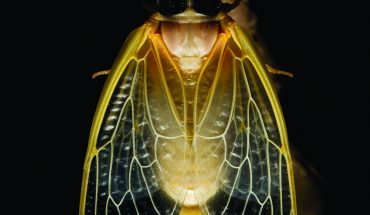
by Liza Roberts
photographs by Annie Cockrill
On a balmy summer evening, guests invited to a dinner for the Jamie Kirk Hahn Foundation followed directions to a “top secret” location in suburban Cary, where an unremarkable street led them to a magical landscape. Among 30 acres of hay fields, gardens, woods, and farmland, guests discovered a tented patio and airy building lit with candles and adorned with wildflowers.
Their hosts, English and Will Sall, welcomed them to the beguiling spot, tucked into the edge of a mature hardwood forest planted with more than 10,000 ferns. With a tennis court on one side and a meadow on the other, the setting appeared tailor-made for a party. It was.

The Salls’ carbarn, a renovated garage, is designed for parties. The patio is perfect for tenting; inside, an open, airy space complete with a kitchen and bathrooms makes it easy to gather large groups. The meadows on the property are planted with “a matrix of native Schizachyrium scoparium (little bluestem) amongst the existing fescue,” says designer Whatley. “Native grasses prefer compacted soil, very little water, and no fertilizer. This makes them a very sustainable choice, because once planted, they require minimal inputs in the future.”

The Salls’ fern gardens are composed of a mix of 10,000 fern plants, most of them one of four species, says landscape designer Daniel Whatley. The most prevalent species is Dryopteris erythrosora (autumn fern), “the strongest performer by far.”
“We use it for big events, cookouts, family dinners,” says Virginia Sall, Will’s mother and the owner, with her husband John (co-founder of software giant SAS), of the building and its surrounding acres. The couple’s house stands above the fern-filled glade, a discreet distance from the hubbub below.

Polystichum polyblepharum (tassel fern) and the deciduous species Matteuccia struthiopteris (ostrich fern) are also planted in large numbers.

All of the ferns were contract grown for the Salls by Johnson’s Nursery in Willard, N.C.

The garden also features some Athyrium filix-femina (lady fern) and Athyrium ‘Ghost’ (ghost fern or Japanese painted fern).
This lush, party-perfect setting is one small piece of a sprawling sustainable landscape that features woods and streams, four acres of organic farmland that grows vegetables for nonprofits and restaurants, and about 15 acres of open fields, all maintained with minimal irrigation and without the use of chemicals.
It got its start, as so many home-improvement projects do, with something much smaller in mind. “The impetus for it all began as a drainage project,” says Kurt Bland of Bland Landscaping, who helped put it all together. “That turned into a shade garden, that became a master planned landscape, which has now spawned a philanthropic teaching farm to cultivate awareness over the importance of healthy, local food systems.

The Salls’ house, which features a wraparound porch, sits on 30 acres of fields, forests, and gardens. Built in 1990, it has been renovated in recent years by Will Alphin.
Bland’s colleague, Daniel Whatley, says the intent is “to create a natural landscape and not a manufactured one.” To accomplish that, “one must not fight nature, because nature will always win.” Instead, the Bland team essentially figured out what already thrived on the land and grew more of it. “A big part of this is allowing the landscape to change and evolve on its own. If a particular species is more successful than another, that is O.K.”
That live-and-let-live philosophy extends to the local deer population, which is numerous. The Salls fenced their vegetable garden and farmland (and a 10-chicken coop, a gift from their friend, N.C. Senator Josh Stein, currently running for Attorney General), but have planted the rest of the property with deer-hardy vegetation. As a result, every evening, when herds emerge from surrounding woods for a stroll in the meadows, they cause no damage.

The turf-roofed “wellhouse” contains well pump equipment, and serves as a home base for the groundskeeper and gardener.
It makes for a bucolic tableau from the eco-friendly carbarn, where the family regularly holds gatherings and fundraisers for local nonprofits (which have also recently included the Institute for Nonprofits at N.C. State). “We love being able to do it, and don’t have to disrupt ourselves, don’t have to move the furniture out of the house, to do it,” Virginia Sall says. “It really dresses up or down, and it’s so cool for the kids.” Those kids – all now grown – also use it for potluck dinners with friends and movies on the lawn, projected onto a portable movie screen.

In the fenced family garden, the Salls grow their favorite vegetables and herbs.
Will Alphin of Alphin Design Build, who has renovated the house and completed several projects on the property, created the carbarn out of what used to be an extra garage. It now incorporates a large event space, a kitchen, bathrooms (with sinks that elegantly channel waste water into toilet cisterns), and hidden storage, in addition to spacious patios on all sides. When not needed for a party, it can also revert back to its earlier incarnation. “We still park in it,” Virginia Sall says.
An honest practicality and lack of pretense is one of the landscape’s defining characteristics. So is a commitment to the future. “This is not a project where we are designing for next season,” Bland says, “as much as we are thinking about the next 50 to 100 years.”



